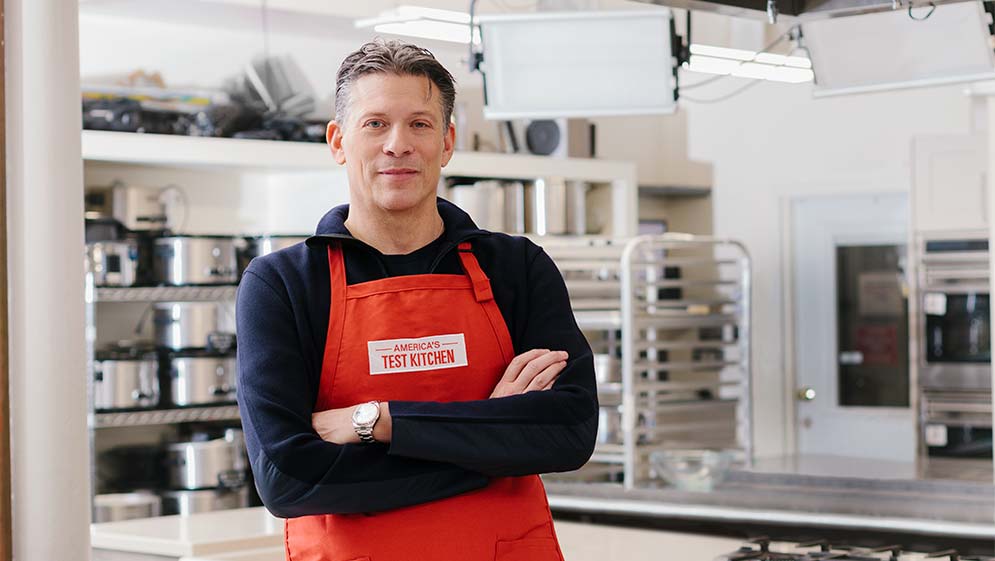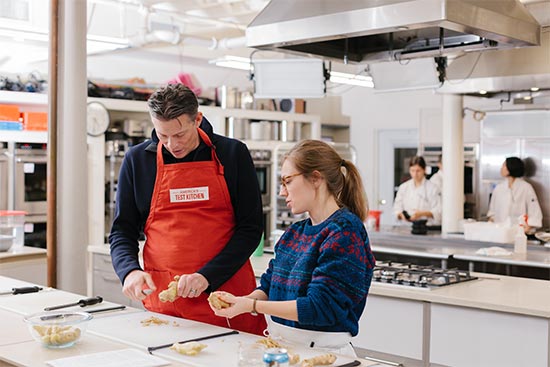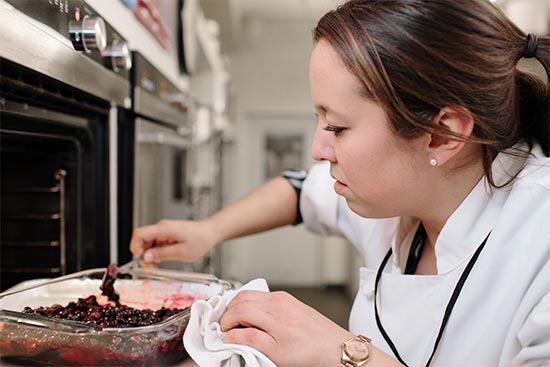Inside America’s Test Kitchen with David Nussbaum (COM’79)
CEO on diversifying a household name—and exit of Christopher Kimball

Since becoming first CEO of America’s Test Kitchen in 2015, media veteran David Nussbaum (COM’79) has made a concerted effort to get into the kitchen.
Watching the CEO of America’s Test Kitchen carefully peel a ginger root, one thing is clear: David Nussbaum is no professional chef.
A media veteran who founded his own trade magazine before he turned 30, Nussbaum (COM’79) stands in the bustling main test kitchen at the Brookline-based company, watching intently as a professional chef—one of more than 50 who develop America’s Test Kitchen recipes—shows him how to quickly strip root after root of its light-brown exterior. (The secret? Use the round edge of a small spoon, not a knife.) Since becoming the company’s first CEO in 2015, Nussbaum has made a concerted effort to get into the kitchen. Like millions of tentative home cooks, he’s been relying on America’s Test Kitchen’s thoroughly vetted recipes to help him avoid culinary catastrophes.
He is especially proud of his American Chop Suey, a dish he made using an America’s Test Kitchen recipe. “Let me show you a picture of it,” he says. He’s determined to find it. For the next five minutes or so, he hunts through his computer for a photo. He gets halfway through a question about filming new shows for PBS without longtime host Christopher Kimball before—bingo! “Here it is, I found it,” he says with excitement. “Here’s what it looks like in the book, and here’s mine; doesn’t it look good? I love this dish, it’s so good. Glad I found that.”
Consistently allowing home cooks to replicate that feeling of triumph—without resorting to complicated techniques or hard-to-find ingredients—has been at the heart of America’s Test Kitchen’s success. For more than two decades, the company has honed a distinctively methodical approach to creating recipes and assessing kitchen tools. It produces two popular PBS shows, America’s Test Kitchen and Cook’s Country, two magazines with more than a million paid subscribers and no ads, scores of cookbooks, an online cooking school, and more.
But this prosperous operation seemed under threat in late 2015. Just two months into Nussbaum’s tenure, it was announced that Kimball—a creative force whose persnickety persona seemed to embody the company’s exacting formula—was leaving. The Boston Globe said Kimball’s departure raised “questions about the future of a venture so closely tied to its star”; NPR noted that the move was “sure to send ripples through a media empire built on a thoughtful and rigorous approach to food.” The ripples intensified to storm surge in October 2016, when America’s Test Kitchen said it was suing Kimball over his new rival cooking venture, Christopher Kimball’s Milk Street. The company claimed Kimball stole proprietary information and plotted the new business on his former employer’s dime. A month or so later, Kimball, who has his own take on events, issued a counterclaim.
Nussbaum had been hired to manage the company’s growth—it had gone from 100 to 180 employees in three years—particularly in the digital sector. “We need somebody who does this job and is focused on business strategy and organization,” chief creative officer Jack Bishop told the Boston Globe at the time. Nussbaum now has to do all of that and convince millions of fans that their beloved source of foolproof recipes is in safe hands.

A CEO, not a test cook
Nussbaum is not a Kimball replacement. Although he started his career as a newspaper reporter on Long Island, N.Y., he’s not going to edit magazines or cookbooks and he’s not appearing on TV—although his team has joked that he can stand in the background and stir something.
“I certainly have had to work hard at convincing my colleagues that I can bring value and that I can be around cooking and our chefs and not be too out of place, but I think people are cool with that,” he says. “I think they realize we have 50 or 60 test cooks here, so they don’t really need their CEO to be a test cook. They need their CEO to be someone who understands how to grow and build a thriving business so that everybody out there can get raises and make more money.”
This is Nussbaum’s third CEO role. Between 2004 and 2006, he took trade publisher Penton Media from near bankruptcy to a $530 million sale by launching new digital businesses and strengthening its events arm. After a year in private equity, he joined F+W Media, transforming it from a publisher of enthusiast magazines into a major media e-commerce player. During his eight-year tenure, he helped launch 30 specialist e-commerce stores, which brought in about $50 million in his last year at the company.
His interest in digital media started before most people had even heard about the internet. “I grew passionate about how media can be transformed by digital,” he says, “so really my success at the two previous companies was due to fully digitizing.”
One of his first initiatives at America’s Test Kitchen was the relaunch of the company’s online cooking school. Changes to the platform included an improved orientation to better match students with lessons that fit their skill level. For a $180 annual membership, wannabe chefs can choose from expert-led courses like Advanced Knife Skills and Authentic Pizza.

“If you’re in the content business, the magazine business, selling online education is not as huge of a leap as selling subscriptions on digital,” says Nussbaum, who’s also leading the launch of an online food and cooking equipment store and a revamp of the company’s mobile sites. “People are accustomed to paying for their education.”
Other changes are coming fast, too: new offices in 2017, a branded food truck, and two new TV shows. In September 2016, cruise company Holland America Line, which hosts 800,000 passengers every year, announced it was bringing America’s Test Kitchen to the high seas. Vacationers on its ships can enjoy cooking demos, join hands-on workshops, and watch America’s Test Kitchen and Cook’s Country around the clock in their cabins. The America’s Test Kitchen experience debuted on Holland America’s Mexico route. Meticulous chefs entertaining alongside lounge singers and pop acts? Will some loyal fans think that’s too much of a stretch for the brand?
“It’s really a very natural link, because the demographics for cruise lines is fairly similar to ours,” says Nussbaum. “What our brand represents to people is great research, great development, terrific recipes, a very thoughtful way of approaching cooking that’s not polluted by an advertiser’s message. That is still fully in lockstep with what we’re doing with some of the brand extension—that’s not changing. It’s just that we want to reach more people in more places.”
America’s Test Kitchen won’t be ditching public television, but it will be pitching new shows to on-demand providers. The magazines will stay in print, too. Nussbaum is a fan—he subscribes to Vanity Fair and ran a commercial real estate publication for about eight years—and he thinks print will stick around, eventually targeting a smaller audience that’s prepared to pay a premium.
But, he says, it’s essential for all media companies to think of themselves as fully integrated—print, digital, live events, online education. He sees the type of deal the New York Times Company made in October 2016 to buy the product review sites Wirecutter and Sweethome as “the future of our business.”
“In media today, you need very strong brands to be financially successful,” he says. “You can never rely on what yesterday was for the strength of your brand—you have to continue to nurture it and build it.”
Behind the paywall
The America’s Test Kitchen offices are filled with comforting aromas, warming stews jostling for olfactory attention with fresh-baked cookies. On one winter afternoon, chefs crowd around two tables, scrutinizing a fried chicken dish and a Korean black bean sauce for noodles. The pleasant waft of sizzling spices isn’t the only thing that distinguishes the company’s headquarters from other editorial offices around the country. America’s Test Kitchen is run using a relatively unusual operating model. There are no ads in its magazines; it buys all its ingredients and equipment at retail. And yet, Nussbaum says, the company is debt-free and growing. In 2016, it added 15 new chefs and content creators and 20 new digital staff.
In part, it’s been able to hang on to its ad-free model because nothing is given away. Aside from the occasional product review, almost all of the privately owned company’s content is behind a paywall. You can watch the programs on PBS, but everything else is subscription-based.

“We really believe we have phenomenal content that we invest a lot in, so why give it away for free?” says Nussbaum. “I think if the media world were able to go back 20 years, they wouldn’t have allowed Google to sweep their content and include it in Search for free. The early models in media were that the web was free. The problem is that it destroyed all revenue generation models.
“You can’t go back in time, but if those media businesses did what we do here and said, ‘You have to pay for the content,’ then I think the media business would be a lot healthier than it is today.”
According to Nussbaum, America’s Test Kitchen’s magazines have a combined circulation of around 1.3 million and renewal rates in the 60 percent range.
That revenue is essential, because the company’s recipes are not cheap to develop. Every dish is created by chefs cooking up to 60 versions of a single recipe, tweaking it at each stage to produce a surefire step-by-step guide. For perfect oven fries, for example, it’s best to trade Yukon Golds (too wimpy-tasting, according to the testers) for russets (which brought a “hearty flavor”) and to soak the raw fries (steaming makes the outsides too tough). Nussbaum says it costs about $10,000 to develop every recipe.
On air with new faces
For many America’s Test Kitchen fans, the most visible change of Nussbaum’s tenure came in January 2017, when PBS aired the first season of America’s Test Kitchen produced under his watch—and the first without Kimball. After lots of consumer panels and testing, two of the company’s longtime chefs and television presenters, Julia Collin Davison and Bridget Lancaster, were chosen as the new cohosts. According to Nussbaum, the show has a little more humor and both hosts have received better Q Scores—familiarity ratings—than Kimball. With more stations carrying the show this year, he hopes that ratings will tick higher (he notes that the company’s shows are already the number one and two practical cooking programs on TV).
“You’re going to have one group that gives it a chance,” Nussbaum says, “you’re going to have one group that will watch it because they love Bridget and Julia, one group that won’t watch it because Chris is gone, and—hopefully—you’re going to have a brand-new group of people who watch it because they are excited by the change.”
Being thrown into the public eye with America’s Test Kitchen has mostly been fun—Nussbaum has been asked to pose for photos and autograph cookbooks—but Kimball’s departure and the subsequent lawsuits upset many, and “there are some people who are not kind to other people on social media.” Still, Nussbaum is confident that tried and tested management methods will help him navigate the post-Kimball future.
“You have to manage your internal audiences and your external audiences when you have such a significant shift like that,” he says. “What I would say is that very good management is still very good management no matter what’s going on.” He checks off treating people with respect, being a visible presence in the office, and encouraging risk-taking as examples. “If you come at a CEO’s job with goodwill, with the intent of making everybody very successful, it’s going to work out.”
Since he started, the company has added profit-sharing, an extra week of vacation, and a new giving-back program, and is preparing a move to bigger offices in Boston’s trendy Seaport District.
Nussbaum is also trying a few more new recipes himself: blue cheese dip, hummus, thin-crust pizza. He’d be happy to show you the photos.


Comments & Discussion
Boston University moderates comments to facilitate an informed, substantive, civil conversation. Abusive, profane, self-promotional, misleading, incoherent or off-topic comments will be rejected. Moderators are staffed during regular business hours (EST) and can only accept comments written in English. Statistics or facts must include a citation or a link to the citation.